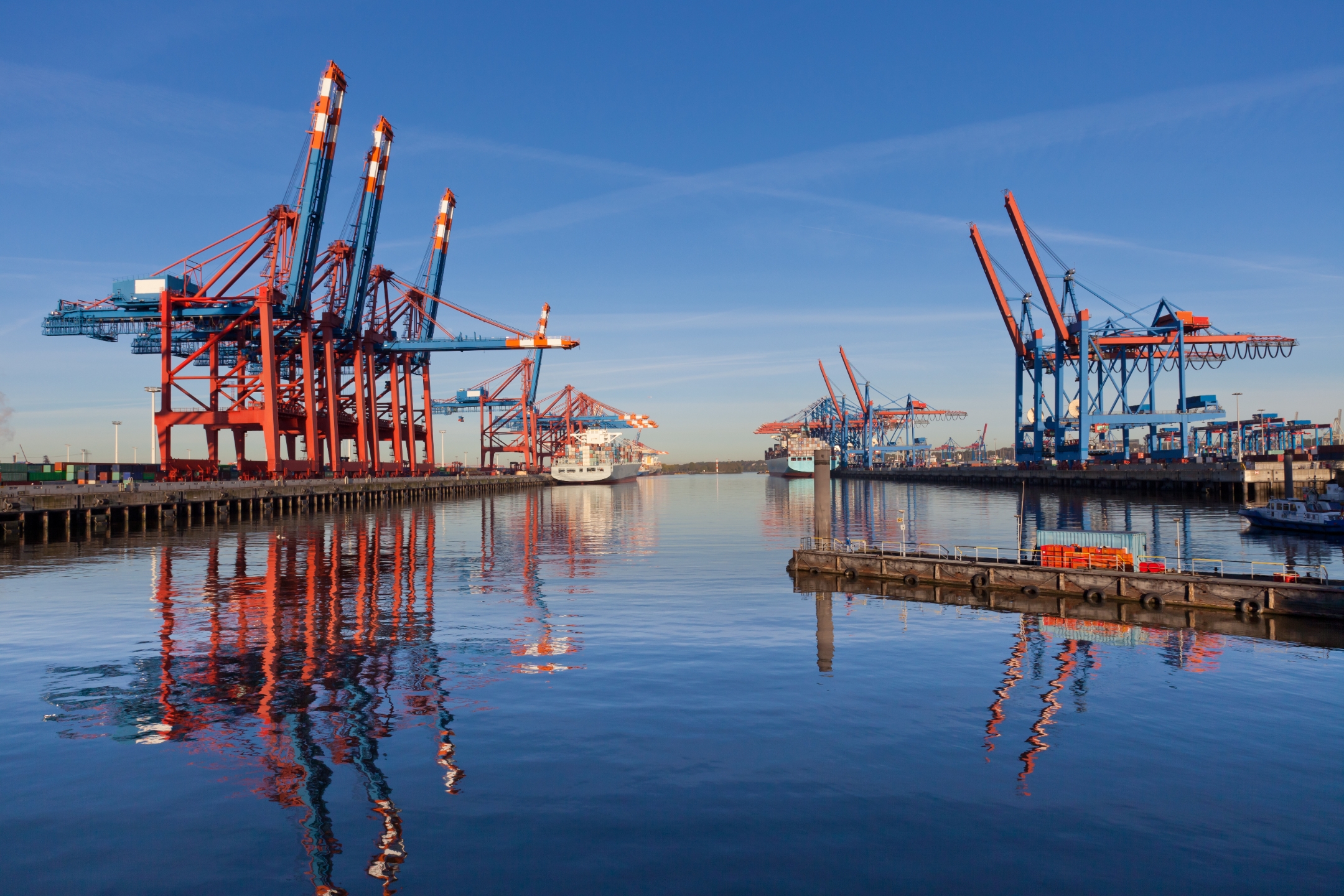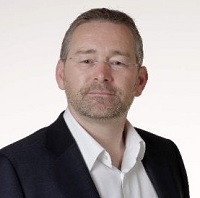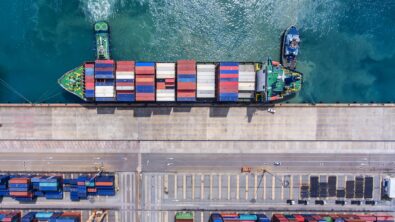Simulating Seaworthy Ships – Transcript

In the third episode of the Marine Industry Podcast Series, Jan van Os and Dale Tutt dive deep into the many ways simulation can be used in ship design, maintenance, and more.

Listen to the original episode or continue below for the transcript.
Blake Snodgrass: Hello, and welcome again to our Marine Podcast Series. This is our third episode, and we are privileged again to continue our conversation with Jan van Os, Vice President of the Marine Industry at Siemens Digital Industries Software, and Dale Tutt, Vice President of Industry Strategy at Siemens. As mentioned in previous podcasts, both Jan and Dale have an extensive background in their respective industries, Jan in the marine industry and Dale Tutt in aerospace, with both of them holding leadership positions with several decades of experience.

Blake Snodgrass: So, I welcome both of them again to this third podcast. Our last podcast focused on sustainability, with our experts drilling down into digitalization of the shipbuilding process, autonomy, supply chain, and other issues. In today’s third podcast of this series, they will address ship design, simulations, maintenance, and shipbuilding. So, Dale, I’m going to let you continue from our last conversation about simulation and digitalization in helping shipbuilders and designers.
Dale Tutt: Hey thanks, Blake, and thanks for having me today. You know, thoughts on how you can change the ship design. Do you do you want to expand maybe a little bit more on how the simulations being used in building the ships and maintaining the ships as well? There’s, yeah, I’ve heard some of the stories about, you know, like, what the some of the digital shipyards like out of Pearl Harbor and other locations is doing. Can you elaborate on that a little bit more?
Jan van Os: Yeah, I can. And we all know about a simulation during design. Of course that’s one thing about [unintelligible] and also the pipe flows etcetera. But if you’re coming to the build, let’s say that it’s already starting with the nesting, but nesting is the cutting of the first pieces of steel. So you can imagine that those are millions of pieces for a big shape. So that’s quite complex but you need to nest and cut those pieces in time and you don’t want to have a whole shop floor with all kinds of pieces which you don’t need. So also there you have already the simulation of that construction area because you have limited space, you’ve got a lot of parts but you have limited space and with the nesting you also are combining parts to get the less waste.
Jan van Os: So if you can simulate that how much material you can cut on the line where you can store it, etc. And I will give you an example. We had a customer who had two production lines with two cutting facilities and they wanted to start a new line for another type of vessel. In this case, it was a line for yards. And they said, “Okay then we have to combine those two production lines into one. “And all the people on the show floor to said, “Oh, that’s not possible. We don’t have the space. We don’t have that. The speed of the machines are not good enough, etc.” And then they did an investment and a simulation on how they could do that. And in the end it was quite easy to get the production from two lines into one line. And what was happening, let’s say, the speed of the machines could be improved, but also the storage space which they normally used, they were cutting pieces which they didn’t use for two months.
Jan van Os: So that means that with all the space they had, they could bring it back to one line and use the other line for yard building. And there you have an investment efficiency and also, let’s say, a better return on investment on your whole shipyard. So, let’s say, people who work already for 30 years on the ship, they say it’s impossible to do, but they don’t have the capability to do those simulations again and again and again and again, fine tune and do the simulations again. So there are some of those examples where you can think about, and if you go from the nesting and the confection of those smaller parts, you go to the panel line where the panels are being built together and the web frames and the frames are being put on. You can imagine the same and then you go to the section building hall where you’re putting the sections together. And it’s all limited space, limited brain capacity. So how can you then improve the optimized line with the equipment that you have, the people which you have and the space which you have.
Jan van Os: So there’s a lot to gain if you really are diving into simulation of the production. If you come later on when you have to blocks and you have a ship, you have a system, and then the whole commissioning is starting and then you have to fine tune and you have to adjust. So also there then you can start doing simulations to improve things and during the commission to make sure that the systems are working optimal and that you fulfill the requirements set in the contract. So there’s a lot of about simulation where you don’t think about in the first place, but if you really look at the shipyard where you can improve cranes, docks, key sites. Those are all limited assets. So if you can use them more optimal, yeah, then you can build more ships, or your ships are shorter, have a shorter time to market. So that there’s a lot of things to gain with simulation in production.
Dale Tutt: Good. Well, thanks for expanding on that. A little bit around the manufacturing piece. So you know, I was thinking about the, you know, going back to the topic that we, you know opened with around sustainability and, you know. as I look at across all the different industries and we have been designing new products with this car and airplane, a tractor. We’ve been designing these products and optimizing on various things. Cost and weight and performance of the, you know, how far the car can go, how fast the airplane can fly. And we’ve been optimizing on so many of these things, these parameters over the years, but now we have sustainability and it’s a new set of requirements and it’s a new way of really evaluating the effectiveness, the performance of your products as well as your manufacturing operations.
Dale Tutt: So let’s go back on that sustainability piece and what we’re seeing in so many industries is that digital transformation is critical for the sustainability piece to help answer those questions. So, how does it help, you know from a marine perspective? You’ve touched on this a little bit already, but maybe let’s just go ahead and revisit that real quick and expand on that a little bit on how sustainability is helping and design and manufacturing and operations.
Jan van Os: Yeah. Well, if you look again to manufacturing and sustainability, then let’s say building a ship is quite energy unfriendly. So the energy consumption of a ship is quite a lot. It’s all beginning with the steel production, which is costing quite some energy. Not only that the raw materials are being transported to the mills, but also heating up to produce the steel and then transporting it back to the areas where it’s needed, that that’s all quite a high carbon footprint. So if we can use sustainability over there to make sure that within the whole building process, you know exactly where our materials are coming from and that we are also using the right mills with less environmental impact.
Jan van Os: So that’s quite important. And then if you have the steel and you have the raw materials, then you can use simulation to use less energy to produce the vessel. And lots of energy is going into the welding and forming of and the cutting of all the parts, and if you can optimize that—and I already said a little bit about brocaded cutting and that you cut in time and what you are cutting, that you’re doing that in the right way optimizing everything—then also the optimization of the welding is quite important. Let’s say if the pieces which you are cutting are spot on and the edges are clean, then you have less welding, or less welding preparation so that you can also reduce the electricity which is necessary for the welding, or simulate the welding in such a way that you have exactly the thickness of the weld.
Jan van Os: So you can think about a lot of sustainability during the process as well to optimize that, to have less carbon footprint during the construction. And of course you can say okay, you have the ship [unintelligible] is not always interested in that part, but more and more what of you see is the social responsibility. It’s not only about the ship operators thinking. It is what the public are thinking, the consumers. You, me, and Blake. What are we thinking? We want to have a product which is built in a sustainable way.
Jan van Os: And that means also that it is transported in a sustainable way. So let’s say the sustainability and the whole value chain is quite important, not only the ship itself, but also how it’s being built and how old the companies which are doing a part of building or designing the vessel. So that is important but on your end, if you look at the shipping industry there are, let’s say, around 100,000 bigger ships above 500 GT sailing across the oceans and they don’t have a digital twin yet. Only a handful, they have a digital twin.
Jan van Os: And they have all the systems onboard. They are not designed in a sustainable way, but they have to comply with also the requirements. So digitalization and simulation etcetera can also help to improve the processes and onboard. So you make a digital twin of the ship, you do scanning or you put some information which is already there, 3D information, 2D information, into a system and then you start doing simulations, optimization of systems, optimization of propulsion systems. And the simplest thing that came out in the past years was, okay if we have to reduce our CO2 footprint, we have to sail slower. Very easy if you drive slower on the highway as well, your car is using less consumption, but ships are designed with a certain speed and they say, “Okay go.” And then they have to wait two days before they can enter the harbor because the people in the harbor are not fast enough to unload or load all the vessels.
Jan van Os: So if the port and the ships, et cetera, is also interconnected, so they can say, “Okay, we’ll use a little bit speed. So we are in time in the port, we don’t have to wait, we burn less fuel.” And that’s also in the operation where you have to think, “Okay, if I can simulate it a little bit and then I can see exactly how much fuel I’m consuming and how much footprint is reduced.” So that’s also a thing.
Jan van Os: And if you then look at what can we do to improve the carbon footprint for the vessels—that’s thinking about scrubbers. You can think about sail assistance, rotors on the vessel, sails which can be used or some other wind assistance for ships to reduce the fuel. So then you have to put a new installation onboard an existing ship. So you need also some digitalization to simulate, okay what is the effect? What is the return on investment? So sustainability is not only in the design and build of the new vessel. It is also affecting the actual 100,000 vessels which are already there to make them more sustainable. And to make sure that they can stay in operations for a longer time also after they have to fulfill the requirements by the IMO. So yeah, sustainability is, already said it’s the key driver for the marine industry at the moment.
Blake Snodgrass: Thank you, Jan, and it looks like we are out of time for this third episode. So again, I want to thank both Jan van Os and Dale Tutt for their contribution for this podcast. And thanks to our listeners for joining us. Please stay tuned for an upcoming fourth podcast episode further exploring the marine industry as we continue discussing a number of topics including sustainability, hydrodynamics, aerodynamics, fuel consumption, efficiency, and the future direction of the shipping industry. So until then, goodbye for now.
Siemens Digital Industries Software helps organizations of all sizes digitally transform using software, hardware and services from the Siemens Xcelerator business platform. Siemens’ software and the comprehensive digital twin enable companies to optimize their design, engineering and manufacturing processes to turn today’s ideas into the sustainable products of the future. From chips to entire systems, from product to process, across all industries. Siemens Digital Industries Software – Accelerating transformation.


